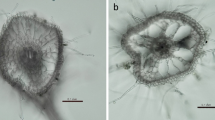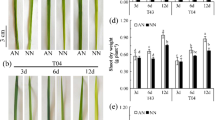Abstract
Under anaerobic conditions, ferric hydroxide deposits on the surface of rice roots have been shown to affect the uptake of some nutrients. In the present experiment, different amount of this iron plaque were induced on the roots of rice (Oryza sativa L. cv. TZ88-145) by supplying different Fe(OH)3 concentrations in nutrient solutions, and the effect of the iron plaque on phosphorus uptake was investigated. Results showed that 1) iron plaque adsorbed phosphorus from the growth medium, and that the amount of phosphorus adsorbed by the plaque was correlated with the amount of plaque; 2) the phosphorus concentration in the shoot increased by up to 72% after 72 h at concentration of Fe(OH)3 in the nutrient solution from 0 to 30 mg Fe/L, corresponding with amounts of iron plaque from 0.2 to 24.5 mg g-1 (root d. wt); 3) the phosphorus concentration in the shoots of rice with iron plaque was higher than that without iron plaque though the concentration in the shoot decreased when Fe(OH)3 was added at 50 mg Fe/L producing 28.3 mg g-1 (root d. wt) of plaque; and 4) the phosphorus concentrations in Fe-deficient and Fe-sufficient rice plants with iron plaque were the same, although phytosiderophores were released from the Fe-deficient roots. The phytosiderophores evidently did not mobilise phosphorus adsorbed on plaque. The results suggest that iron plaque on rice plant roots might be considered a phosphorus reservoir.
Similar content being viewed by others
References
Armstrong J and Armstrong W 1988 Phragmites australis preliminary study of soil-oxdizing sites and internal gas transport pathways. New Phytol. 108, 373–382.
Armstrong W 1967The oxidizing activity of roots in waterlogged soils. Physiol. Plant.20, 540–543.
Atkinson R J, Parfitt R L and Swart St C 1974Infra-red study of phosphate on goethite. J. Chem. Soc. Faraday Trans. 70, 1472–1479.
Bacha R E and Hossner L R 1977Characteristics of coatings formed on rice roots as affected by iron and manganese additions. Soil Sci. Soc. Amer. J. 41, 931–935.
Bienfait H F, Brie WV D and Mesland-Mul N T 1984Measurement of the extracellular mobilizable iron pool in roots. J. Plant Nutr. 7, 659–666.
Bienfait H F, Briel W V D and Mesland-Mul N T 1985Free space iron pools in roots. Plant Phys. 78, 596–600.
Chen C C, Dickson J B and Turner F T 1980Iron coating on rice roots: morphology and models of development. Soil Sci, Soc. Amer. J. 44, 1113–1119.
Conlin T S S and Crowder A A 1989Location of radial oxygen loss and zones of potential iron uptake in a grass and two non-grass emergent species.Can. J. Bot.67, 717–722.
Crowder A A and MacFie S M 1986Seasonal deposition of ferric hydroxide plaque on roots of wetland plants.Can. J. Bot. 64, 2120–2124.
Crowder A A and St.-Cyr L 1991Iron oxide plaque on wetland roots. Trends Soil Sci. 1, 315–329.
Greipsson S 1995Effect of iron plaque on roots of rice on growth of plants in excess zinc and accumulation of phosphorus in plant in excess copper or nickel. J. Plant Nutr. 18, 1659–1665.
Greipsson S and Crowder A A 1992Amelioration of copper and nickel toxicity by iron plaque on roots of rice. Can. J. Bot.70, 824–830.
Howeler R H 1973Iron-induced oranging disease of rice in relation to physiochemical change in a flooded oxisol. Soil Sci. Soc. Amer. Proc. 437, 898–903.
Iremonger S F and Kelly D L 1988The responses of four Irish wetland tree species to raised soil water levels. New Phytol. 109, 491–497.
Jones R and Etherington J R 1973Comparative studies of plant growth and distribution in relation to waterlogging. The uptake of phosphorus by dune and dune slack plants. J. Ecol. 61, 109–116.
Kuo S 1986Concurrent sorption of phosphorus and zinc, cadmium, or calcium by a hydrous ferric oxide. Soil Sci. Soc. Amer. J. 50, 1412–1419.
Nagarajah S, Posner A M and Quirk J P 1970Competitive adsorption of phosphate with polygalacturonate and other organic anions on kaolinite and oxide surfaces. Nature 228, 83–84.
Otte M L 1991Heavy metal and arsenic in vegetation of salt marshes and floodplains. Doctoral Thesis, Vrije University, Amsterdam, The Netherlands.
Otte M L, Dekkers M J, Rozema J and Broekman R A 1991Uptake of arsenic by Aster tripolium in relation to rhizosphere oxidation. Can. J. Bot. 69, 2670–2677.
Otte M L, Rozema J, Koster L, Haarsma M S and Broekman R A 1989Iron plaque on roots of Aster tripolium L. interaction with zinc uptake.New Phytol. 111, 309–317.
Page A L, Miller, R H and Keeney D R 1995Methods of Soil Analysis (4th Edn.). American Society of Agronomy, Inc. Soil Science Society of America, Inc.: Madison, WI.
Parfitt R L, Rager S and Smart C 1978Adsorption on hydrous oxides: mechanisms of adsorption of various ions on goethite. J. Soil Sci. 28, 297–305.
Shuman LM 1977Adsorption of Zn by Fe and Al hydrous oxides as influenced by ageing and pH. Soil Sci. Soc. Amer. J. 41, 703–706.
St.-Cyr L, Fortin D and Campbell P G C 1993Microscopic observation of the iron plaque of a submerged aquatic plant vallisneria americana michx. Botany 46, 155–167.
Takagi S 1976Naturally occurring iron chelating compounds in oatand-rice-root washing.Soil Sci. Plant Nutr. 12, 423–433.
Tanaka A, Loe R and Navasero S A 1966Some mechanism in involved in the development of iron toxicity symptoms in the rice plant. Soil Sci. Plant Nutr. 12, 158–164.
Taylor G T and Crowder A A 1983Use of DCB technique for extraction of hydrous iron oxides from roots of wetland plant. Amer. J. Bot. 70, 1254–1257.
Wang T G and Peverly J H 1996Oxidation states and fractionation of plaque iron on roots of common reeds. Soil Sci. Amer. J. 60, 323–329.
Zhang F S, Römheld V and Marschner H 1991Role of the root apoplasm for iron acquisition by wheat plant. Plant Physiol. 97, 1302–1305.
Zhang X K, Zhang F S and Mao D R 1996Effect of root iron plaque on zinc uptake by rice plant. Chinese Acta Appl. Ecol. 7, 262–266.
Author information
Authors and Affiliations
Rights and permissions
About this article
Cite this article
Zhang, X., Zhang, F. & Mao, D. Effect of iron plaque outside roots on nutrient uptake by rice (Oryza sativa L.): Phosphorus uptake. Plant and Soil 209, 187–192 (1999). https://doi.org/10.1023/A:1004505431879
Issue Date:
DOI: https://doi.org/10.1023/A:1004505431879




